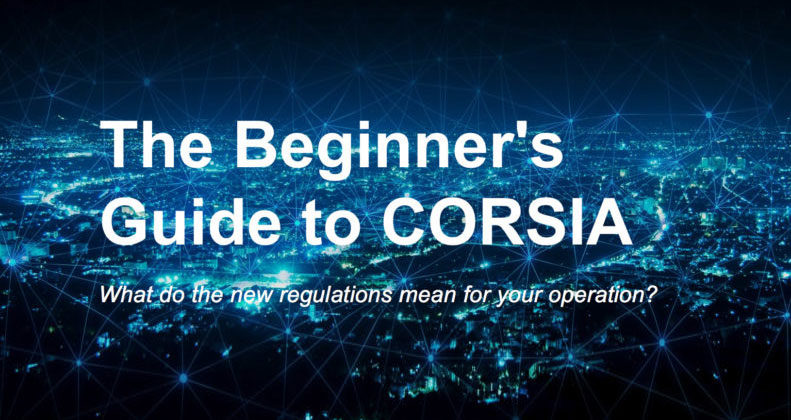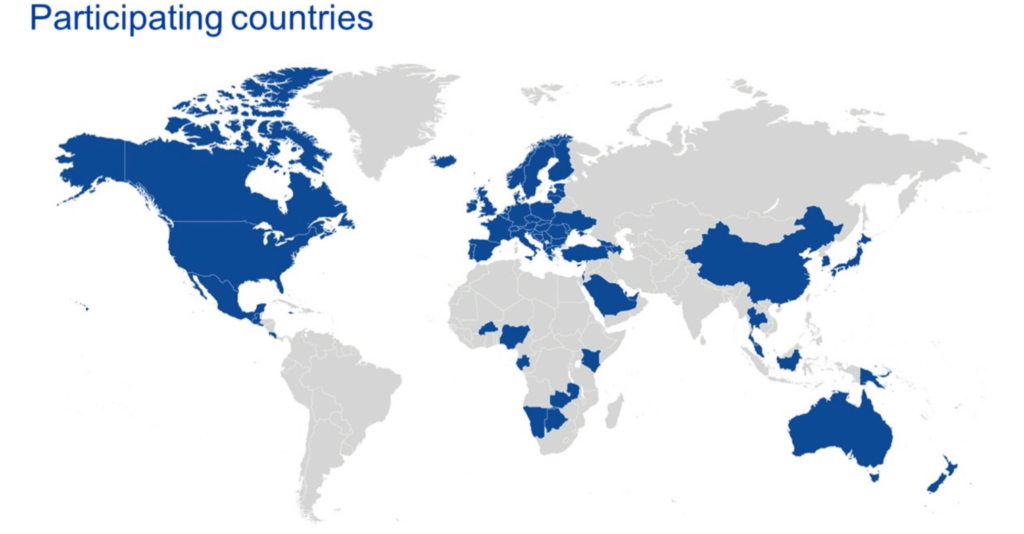
The Beginner’s Guide to CORSIA Regulations
You’ve probably heard rumblings about a new aviation emissions regulation called CORSIA. But what is it exactly, and what does it mean for you?
Let’s dig in.
What is CORSIA, Anyway?
CORSIA (Carbon Offsetting and Reduction Scheme for International Aviation) is a plan created by the International Civil Aviation Organization (ICAO), the governing body for all international flying. It’s not a tax: it’s a market-based measure designed to encourage airlines and aircraft operators to reduce and counteract their CO2 emissions from international flights.
To Carbon Neutrality and Beyond
Many aircraft operators, especially those with routes in the European Union (EU), are familiar with EU ETS’ requirement to regulate emissions. EU ETS will still be in place for the foreseeable future in addition to CORSIA.
However, there are some key differences between EU ETS and CORSIA. While EU ETS regulates emissions, CORSIA aims to make the international aviation industry carbon neutral from 2020. This requires the aviation industry to offset emissions by purchasing credits that support projects dedicated to removing carbon from the atmosphere or create clean energy.
A Phased Approach
CORSIA is broken into phases. The monitoring phase is mandatory for all CORSIA-eligible operators beginning on January 1, 2019, and the offsetting phase will not be mandatory for a few years.

Monitoring Phases
All operators who meet the eligibility criteria (hyperlink to “How to tell if CORSIA affects you”) should submit an Emissions Monitoring Plan for state approval by September 30, 2018. Submission by this date is no longer mandatory but ensures operators will receive either approval or edit requirements by November 30, 2018. The firm deadline for Emissions Monitoring Plan submissions is February 28, 2019.
These dates are approaching quickly, so you should act now to check your eligibility and create a plan to being begin monitoring your emissions. Keep in mind that is it mandatory to begin monitoring your emissions on January 1, 2019.
Offsetting Phases
Offsetting emissions is in the phased part of the plan and is not mandatory right away. In fact, it will be route dependent until 2027, when all international routes (with a few exceptions) will require offsetting when flown by CORSIA-eligible operators. To learn more about the phases, read our follow-up post “How CORSIA Will Affect You.”
What are the Eligibility Requirements?
Aircraft that are eligible for CORSIA are those that meet a weight requirement and burn enough fuel. Specifically, those are aircraft that:
- Have a maximum takeoff weight of 5,700 kg (approximately 12,500 lbs)
- Emit more than 10,000 tonnes of CO2 annually (burn approximately 3,500 tonnes or 3858.09 US tons of fuel annually)

Does your operation meet these criteria?
If you’re not sure what this means for your operation, check out our free CORSIA calculator. You’ll probably be surprised about how quickly a small plane flying enough short routes can qualify as an operator for CORSIA.
What Does Monitoring Entail?
Any operator that meets the eligibility requirements is required to begin monitoring, reporting and verifying (MRV) their CO2 emissions from all international flights by January 1, 2019. You can learn more about eligibility requirements in our post How to Tell if CORSIA Effects You.
We explained this above, but it bears repeating: you should submit your Emissions Monitoring Plan to your state authorities by September 30th, 2018 to get your approval back by November 30th, 2018.
What Do I Need to Know About Carbon Offsetting?
If your operation is eligible for CORSIA, MRV is required for all of your international routes. In addition, some international routes are also eligible for carbon emissions offsetting.
Between 2021 and 2026, routes flown by CORSIA eligible operators from voluntary Participating States to other Participating States are eligible for offsetting. Routes flown between a Participating State and a non-participating state, or between two non-participating states are not eligible for offsetting.
In 2027, however, all international routes become mandatory with a few exceptions.

Participating States as of May 2018. More countries are voluntarily joining, so we can expect more routes to require offsetting in the future.
You need to track your emissions so you can report them and purchase offsetting credits for emissions above the 2020 baseline. For more information about offsetting, check out How Will CORSIA Affect You.
Between now and 2027, we can expect the amount of international air traffic eligible for offsetting to increase. As more states become Participating States to help protect the environment, more routes will be eligible for offsetting.
Next steps you should take
After determining how CORSIA affects your operation, you’ll need to start making plans for MRV. Remember, your Emissions Monitoring Plan should be turned in to your state authority by September 30, 2018.
If you’re overwhelmed at this point, you’re not alone. You can check out our overview here, and we also have some tips to help you prepare for CORSIA. Specifics for CORSIA are available from ICAO here.
You’ve probably heard rumblings about a new aviation emissions regulation called CORSIA. But what is it exactly, and what does it mean for you?
Let’s dig in.
What is CORSIA, Anyway?
CORSIA (Carbon Offsetting and Reduction Scheme for International Aviation) is a plan created by the International Civil Aviation Organization (ICAO), the governing body for all international flying. It’s not a tax: it’s a market-based measure designed to encourage airlines and aircraft operators to reduce and counteract their CO2 emissions from international flights.
To Carbon Neutrality and Beyond
Many aircraft operators, especially those with routes in the European Union (EU), are familiar with EU ETS’ requirement to regulate emissions. EU ETS will still be in place for the foreseeable future in addition to CORSIA.
However, there are some key differences between EU ETS and CORSIA. While EU ETS regulates emissions, CORSIA aims to make the international aviation industry carbon neutral from 2020. This requires the aviation industry to offset emissions by purchasing credits that support projects dedicated to removing carbon from the atmosphere or create clean energy.
A Phased Approach
CORSIA is broken into phases. The monitoring phase is mandatory for all CORSIA-eligible operators beginning on January 1, 2019, and the offsetting phase will not be mandatory for a few years.

Monitoring Phases
All operators who meet the eligibility criteria (hyperlink to “How to tell if CORSIA affects you”) should submit an Emissions Monitoring Plan for state approval by September 30, 2018. Submission by this date is no longer mandatory but ensures operators will receive either approval or edit requirements by November 30, 2018. The firm deadline for Emissions Monitoring Plan submissions is February 28, 2019.
These dates are approaching quickly, so you should act now to check your eligibility and create a plan to being begin monitoring your emissions. Keep in mind that is it mandatory to begin monitoring your emissions on January 1, 2019.
Offsetting Phases
Offsetting emissions is in the phased part of the plan and is not mandatory right away. In fact, it will be route dependent until 2027, when all international routes (with a few exceptions) will require offsetting when flown by CORSIA-eligible operators. To learn more about the phases, read our follow-up post “How CORSIA Will Affect You.”
What are the Eligibility Requirements?
Aircraft that are eligible for CORSIA are those that meet a weight requirement and burn enough fuel. Specifically, those are aircraft that:
- Have a maximum takeoff weight of 5,700 kg (approximately 12,500 lbs)
- Emit more than 10,000 tonnes of CO2 annually (burn approximately 3,500 tonnes or 3858.09 US tons of fuel annually)

Does your operation meet these criteria?
If you’re not sure what this means for your operation, check out our free CORSIA calculator. You’ll probably be surprised about how quickly a small plane flying enough short routes can qualify as an operator for CORSIA.
What Does Monitoring Entail?
Any operator that meets the eligibility requirements is required to begin monitoring, reporting and verifying (MRV) their CO2 emissions from all international flights by January 1, 2019. You can learn more about eligibility requirements in our post How to Tell if CORSIA Effects You.
We explained this above, but it bears repeating: you should submit your Emissions Monitoring Plan to your state authorities by September 30th, 2018 to get your approval back by November 30th, 2018.
What Do I Need to Know About Carbon Offsetting?
If your operation is eligible for CORSIA, MRV is required for all of your international routes. In addition, some international routes are also eligible for carbon emissions offsetting.
Between 2021 and 2026, routes flown by CORSIA eligible operators from voluntary Participating States to other Participating States are eligible for offsetting. Routes flown between a Participating State and a non-participating state, or between two non-participating states are not eligible for offsetting.
In 2027, however, all international routes become mandatory with a few exceptions.

Participating States as of May 2018. More countries are voluntarily joining, so we can expect more routes to require offsetting in the future.
You need to track your emissions so you can report them and purchase offsetting credits for emissions above the 2020 baseline. For more information about offsetting, check out How Will CORSIA Affect You.
Between now and 2027, we can expect the amount of international air traffic eligible for offsetting to increase. As more states become Participating States to help protect the environment, more routes will be eligible for offsetting.
Next steps you should take
After determining how CORSIA affects your operation, you’ll need to start making plans for MRV. Remember, your Emissions Monitoring Plan should be turned in to your state authority by September 30, 2018.
If you’re overwhelmed at this point, you’re not alone. You can check out our overview here, and we also have some tips to help you prepare for CORSIA. Specifics for CORSIA are available from ICAO here.
